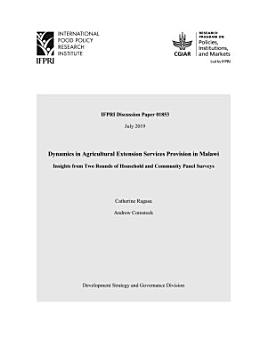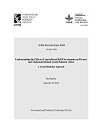Dynamics in agricultural extension services provision in Malawi: Insights from two rounds of household and community panel surveys
Ragasa, Catherine · Comstock, Andrew
ສ.ຫ. 2019 · IFPRI Discussion Paper ຫົວທີ 1 · Intl Food Policy Res Inst
ປຶ້ມອີບຸກ
50
ໜ້າ
family_home
ມີສິດ
info
reportບໍ່ໄດ້ຢັ້ງຢືນການຈັດອັນດັບ ແລະ ຄຳຕິຊົມ ສຶກສາເພີ່ມເຕີມ
ກ່ຽວກັບປຶ້ມ e-book ນີ້
The Government of Malawi is in the process of developing its National Agricultural Extension Strategy. Two rounds of national household and community surveys (2016, 2018), coupled with in-depth interviews and focus group discussions, were implemented to provide research evidence supporting the Strategy’s development. This paper summarizes emerging trends from these surveys and monitors progress in extension services provision, players and actors in extension services provision, and evidence on the coverage and effectiveness of extension approaches. Positive trends include (1) improvements in the percentage of men and women farmers accessing extension services; (2) consistently high ratings in the perceived quality of extension services; (3) more diversity in extension messages, including more information regarding market access and nutrition; (4) greater use of cost-effective tools, such as radio programming and community or group meetings, as sources of agricultural information; and (5) greater crop diversification, although diversification outside of agriculture remains low. Four areas remain weak and need further improvements. First, information sharing among farmers, friends, and neighbors is frequent, and the coverage of those officially trained “lead farmers” (those trained specifically to promote technologies to other farmers) remains low, with only 7 percent of households reporting getting relevant advice from them. Second, while there are more “model villages” and “village agricultural committees” present, we see decreasing participation and ratings for these. Third, we observe greater awareness of promoted technologies, including conservation agriculture, pit planting, and sustainable land practices, but adoption remains very low. Fourth, we observe greater crop diversification, but farm productivity and commercialization remain low. Although we have investigated many dimensions and factors in this paper, there remain challenges and puzzles that could be further addressed in future research. These include constraints on the adoption of minimal expensive inputs and low-cost management practices, constraints on the role of intensive training and labor, and understanding the drivers and factors affecting commercialization and diversification.
ໃຫ້ຄະແນນ e-book ນີ້
ບອກພວກເຮົາວ່າທ່ານຄິດແນວໃດ.
ອ່ານຂໍ້ມູນຂ່າວສານ
ສະມາດໂຟນ ແລະ ແທັບເລັດ
ຕິດຕັ້ງ ແອັບ Google Play Books ສຳລັບ Android ແລະ iPad/iPhone. ມັນຊິ້ງຂໍ້ມູນໂດຍອັດຕະໂນມັດກັບບັນຊີຂອງທ່ານ ແລະ ອະນຸຍາດໃຫ້ທ່ານອ່ານທາງອອນລາຍ ຫຼື ແບບອອບລາຍໄດ້ ບໍ່ວ່າທ່ານຈະຢູ່ໃສ.
ແລັບທັອບ ແລະ ຄອມພິວເຕີ
ທ່ານສາມາດຟັງປຶ້ມສຽງທີ່ຊື້ໃນ Google Play ໂດຍໃຊ້ໂປຣແກຣມທ່ອງເວັບຂອງຄອມພິວເຕີຂອງທ່ານໄດ້.
eReaders ແລະອຸປະກອນອື່ນໆ
ເພື່ອອ່ານໃນອຸປະກອນ e-ink ເຊັ່ນ: Kobo eReader, ທ່ານຈຳເປັນຕ້ອງດາວໂຫຼດໄຟລ໌ ແລະ ໂອນຍ້າຍມັນໄປໃສ່ອຸປະກອນຂອງທ່ານກ່ອນ. ປະຕິບັດຕາມຄຳແນະນຳລະອຽດຂອງ ສູນຊ່ວຍເຫຼືອ ເພື່ອໂອນຍ້າຍໄຟລ໌ໄໃສ່ eReader ທີ່ຮອງຮັບ.











